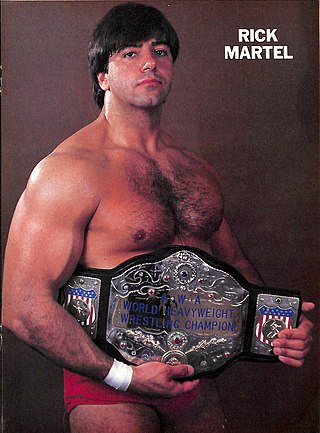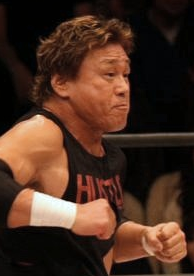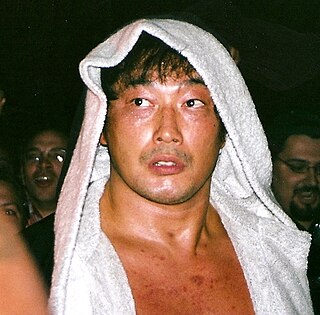
Super World of Sports, also known as Super World Sports or simply as SWS, was a Japanese professional wrestling promotion from 1990 to 1992. Its motto was "Straight and Strong".

Leon Allen White, better known by his ring names Big Van Vader or simply Vader, was an American professional wrestler and professional football player. Throughout his career, he performed for New Japan Pro-Wrestling (NJPW), Catch Wrestling Association (CWA), World Championship Wrestling (WCW), the World Wrestling Federation (WWF), All Japan Pro Wrestling (AJPW), and Pro Wrestling Noah (NOAH) during the 1990s and 2000s. He is widely regarded as the greatest super-heavyweight professional wrestler of all time.

Raymond Constantine Fernandez Jr. was an American professional wrestler better known by his ring name Hercules Hernandez, or simply Hercules. Fernandez began his career in 1979, primarily wrestling in Florida and Texas before earning his greatest success by joining the World Wrestling Federation in 1985, where he was a member of The Heenan Family. He later split from the stable and feuded with Heenan and Ted DiBiase, afterwards turning heel in 1990, forming Power and Glory with Paul Roma, where they had a feud with The Rockers. Fernandez was also a featured bodybuilder, appearing in several muscle magazines. He is also known for his appearances in World Championship Wrestling, Jim Crockett Promotions, and New-Japan Pro Wrestling.

Mitsuharu Misawa was a Japanese professional wrestler and promoter. He is primarily known for his 18-year stint with All Japan Pro Wrestling (AJPW), and for forming Pro Wrestling Noah in 2000. In the early 1990s, Misawa gained fame alongside Toshiaki Kawada, Kenta Kobashi, and Akira Taue, who came to be nicknamed AJPW's "Four Pillars of Heaven", and whose matches developed the ōdō style of puroresu and received significant critical acclaim. Despite never working in the United States during the 1990s, Misawa had a significant stylistic influence upon independent wrestling, through the popularity of his work among tape-traders worldwide including the United States, the United Kingdom, Canada, and Australia.

WrestleMania IV was the fourth annual WrestleMania professional wrestling pay-per-view (PPV) event produced by the World Wrestling Federation. The event took place on March 27, 1988, at Boardwalk Hall in Atlantic City, New Jersey. The announced attendance of the event was 19,199.

WrestleMania VI was the sixth annual WrestleMania professional wrestling pay-per-view (PPV) event produced by the World Wrestling Federation. It took place on April 1, 1990, at the SkyDome in Toronto, Ontario, Canada, marking the first WrestleMania to be held outside of the United States. The event had an announced attendance of 67,678, a record for the Skydome at the time. The main event of WrestleMania VI was "the Ultimate Challenge" — pitting WWF World Heavyweight Champion Hulk Hogan against WWF Intercontinental Heavyweight Champion the Ultimate Warrior in a Winner Takes All match.

WrestleMania VII was the seventh annual WrestleMania professional wrestling pay-per-view (PPV) event produced by the World Wrestling Federation. It took place on March 24, 1991, at the Los Angeles Memorial Sports Arena in Los Angeles. Fourteen matches were shown during the live broadcast, with one dark match held before the event.

John Anthony Tenta Jr. was a Canadian professional wrestler and sumo wrestler (rikishi) best known for his work in the World Wrestling Federation as Earthquake, though initially known as Canadian Earthquake.

Richard Vigneault is a Canadian retired professional wrestler, trainer, and television presenter, better known by his ring name, "The Model" Rick Martel. He is best known for his appearances with the American Wrestling Association, the World Wrestling Federation and World Championship Wrestling. Championships held by Martel over the course of his career include the AWA World Heavyweight Championship, WCW World Television Championship, and WWF World Tag Team Championship.

Tonga ʻUliʻuli Fifita is a Tongan professional wrestler, best known for his appearances in the World Wrestling Federation and New Japan Pro-Wrestling (NJPW) under the ring name Haku and his appearances with World Championship Wrestling (WCW) as Meng.

Steven Franklin Williams, best known under the ring name "Dr. Death" Steve Williams, was an American collegiate and professional wrestler and collegiate football player. He was known for his tenures in World Championship Wrestling (WCW) and All Japan Pro Wrestling (AJPW), and is a three-time professional wrestling world heavyweight champion, having won both the Herb Abrams and Bill Watts versions of the UWF World Heavyweight Championship and the AJPW Triple Crown Heavyweight Championship.

John Stanley "Stan" Hansen II, best known as Stan "The Lariat" Hansen, is an American retired professional wrestler.

Genichiro Shimada, better known as Genichiro Tenryu is a Japanese retired professional wrestler and professional wrestling promoter. At age 13, he entered sumo wrestling and stayed there for 13 years, after which he turned to Western-style professional wrestling. "Tenryu" was his shikona. He had two stints with All Japan Pro Wrestling (AJPW), where he spent the majority of his career while also promoting Super World of Sports (SWS), Wrestle Association R (WAR) and Tenryu Project. He is widely considered to be one of the greatest professional wrestlers of all time. At the time of his retirement, professional wrestling journalist and historian Dave Meltzer wrote that "one could make a strong case [that Tenryu was] between the fourth and sixth biggest native star" in the history of Japanese professional wrestling.

Kenta Kobashi is a Japanese professional wrestling promoter and retired wrestler. Broadly referred to by the nickname "Tetsujin", he is widely regarded as one of the greatest professional wrestlers of all time. He is best known for his two runs in All Japan Pro Wrestling (AJPW) and Pro Wrestling Noah (NOAH), of which he captured AJPW's Triple Crown Heavyweight Championship thrice, and NOAH's GHC Heavyweight Championship once. He is the winner of numerous Match of the Year and Wrestler of the Year awards, including from the Wrestling Observer Newsletter (WON) and Tokyo Sports.

Wrestle Association R was a Japanese professional wrestling promotion founded and run by Genichiro Tenryu as the successor to Super World of Sports, and which lasted from 1992 to 2000. The promotion initially established as Wrestle and Romance in 1992 and had very few regular contracted workers; instead most of the workers were either freelance or employed in other promotions. Because of this WAR ran many all-star cards. It had inter-promotional feuds against New Japan Pro-Wrestling, Frontier Martial-Arts Wrestling, the new Tokyo Pro Wrestling, and UWF International. WAR also continued, albeit in a loose fashion, SWS's old working agreement with the World Wrestling Federation, when they backed the WWF's first Japanese tour, in 1994.

Mitsuo Yoshida, better known by his ring name Riki Choshu, is a South Korean-Japanese retired professional wrestler who is best known for his longtime work in New Japan Pro-Wrestling (NJPW) as both a wrestler and a booker. He is considered one of Japan’s most influential wrestlers for his work in the 1980s and 1990s and is known as the first wrestler to popularize the Sasori-Gatame, better known in English as the Scorpion Deathlock or Sharpshooter. After leaving NJPW in 2002, he formed Fighting World of Japan Pro Wrestling (WJ), but eventually returned to New Japan in October 2005 as a site foreman, booker and part-time wrestler. Choshu once again left NJPW in 2010 and primarily worked in Tatsumi Fujinami’s Dradition, as well as his own self-produced Power Hall events as a freelancer. Choshu was a second generation Zainichi Korean. He was naturalized in 2016.

The Road Warriors, also known as the Legion of Doom, were a professional wrestling tag team originally composed of Road Warrior Hawk and Road Warrior Animal. They performed under the name "The Road Warriors" in the American Wrestling Association (AWA), the National Wrestling Alliance (NWA), and World Championship Wrestling (WCW), and the name "Legion of Doom" (LOD) in the World Wrestling Federation (WWF). Under either name, their gimmick was the same – two imposing wrestlers in face paint. For brief periods, other wrestlers were added as stand-in partners for both men. In Japan in the 1990s, "Power Warrior" Kensuke Sasaki often teamed with Hawk and Animal, separately and together, while in WWE were joined by Droz in the 1990s and Heidenreich in the 2000s. The team also had three managers: Sunny in the 1990s, Christy Hemme in the 2000s, and Paul Ellering, the manager associated with the original team.
Revolution was a professional wrestling stable in All Japan Pro Wrestling (AJPW) led by Genichiro Tenryu.

The 2000 All Japan Pro Wrestling mass exodus was an incident in the Japanese All Japan Pro Wrestling (AJPW) professional wrestling promotion that took place throughout May and June 2000, and culminated in 24 of the 26 contracted native wrestlers leaving the promotion. Led by Mitsuharu Misawa, they later formed their own promotion, Pro Wrestling Noah.

This is a list chronicling the history of professional wrestling at the Tokyo Dome. The Tokyo Dome stadium in Bunkyo, Tokyo, Japan has hosted a number of professional wrestling supercard events over the years. These events often air on pay-per-view (PPV) or are recorded for a future television broadcast. New Japan Pro-Wrestling (NJPW) is the promotion which has held the most shows at the Tokyo Dome, including the very first professional wrestling event at the venue – Battle Satellite in Tokyo Dome on April 24, 1989. NJPW also holds their annual January 4 Tokyo Dome Show event, currently promoted under the Wrestle Kingdom name – Wrestle Kingdom is considered NJPW's biggest show of the year, their version of WrestleMania. The first January 4 show, Super Warriors in Tokyo Dome, took place in 1992 and has been held each year since then. As of night two of Wrestle Kingdom 15, NJPW has held a total of 55 shows in the Tokyo Dome.


















